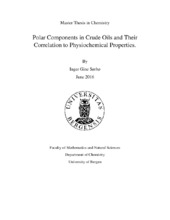| dc.description.abstract | The composition and properties of crude oils have been subjected to much scrutinization over the past decades due to the decreasing oil quality and thus increasingly difficult oil recovery. The physical properties of crude oils are found to be very dependent on the chemical composition. This complex relationship is important to understand in order to predict what EOR method is best suited for one specific oil type. The aim of this work has been to improve the understanding of how polar components in a crude oil will affect physiochemical properties such as interfacial tension, contact angle and zeta potential. These physiochemical properties measurements are important factors in reservoir interactions. Due to the complex nature of the crude oil composition, fractionation by chemical properties was used to simplify the characterization of polar compounds. The asphaltene fraction was recovered by precipitation with n-hexane. The maltene oil was fractionated into four increasingly polar fractions by SPE-LC. These fractions were further analyzed by FT-IR and 31P NMR. The 31P NMR analytical technique was utilized for the first time in the analysis of crude oils. It was found to have an interesting potential in the molecular characterization of polar compounds. In addition to chemical composition, the biodegradation ranks and TAN were found for each crude oil. The physiochemical properties measured by Kolltveit, and the chemical component data obtained in this thesis, were analyzed by principal component analysis (PCA). The analysis revealed that the heavier and more biodegraded oils consisted of more carboxylic acid functional groups, while the lighter, non-biodegraded contained more aliphatic alcohols and phenolic functional groups. The physiochemical properties were found to be less dependent on the amount of TAN and more dependent on the chemical composition of the acids present in the crude oils. The TAN was found to be independent of the asphaltenes, indicating that the acids are present in both the maltene and asphaltene fractions. | en_US |
